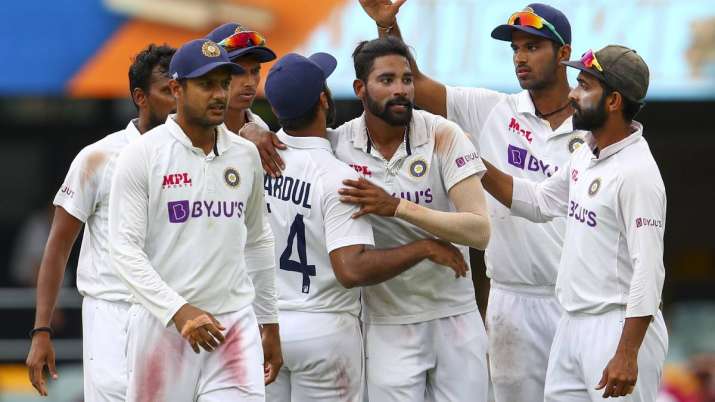[ad_1]

India’s Mohammed Siraj, centre, is congratulated by teammates after taking his fifth wicket during play on day four of the fourth cricket test between India and Australia at the Gabba, Brisbane, Australia, Monday, Jan. 18
Rain washed a majority of the final session on day 4 after Australia set a target of 328. India were supposed to face 24 overs of the new ball on a track that had shown ominous signs with inconsistent bounce and cracks opening up, but the openers only faced 11 balls scoring four runs before the final spell of shower sent the two sides packing to the dressing room. The daunting task, nevertheless, awaits India who will have to defy odds and history to retain the Border-Gavaskar trophy?
ADVANTAGE AUSTRALIA?
328 isn’t among the highest targets set by a team at the Gabba. But Australia have failed to win only twice when a target of 328 or more has been set at this venue – against England in 1998 and 1962 – winning in the rest 12 matches. Adding to India’s woe, the highest successful chase at the Gabba is Australia’s 236 for seven against West Indies in 1951.
India have scored 300 or more 19 times in the fourth innings, but only twice have they managed to secure a win – against England in Chennai in 2008 and the most memorable one, at Port of Spain against West Indies in 1976, which remains India’s highest successful in Test cricket. 14 of those scores have come away from home, six of them in Australia. Overall, India have not been good in chasing 300 or more total, losing 45 out of 80 such instances while 32 ended in a draw.
Not to forget, the Gabba is Australia’s fortress, having never lost at the venue since 1988. They played 32 matches since then and only eight ended in a draw. In fact, their overall win-loss ratio is the highest for Australia at any venue – 40 wins in 63 Tests with just eight defeats. India have played seven and lost five.
BUT IT’S NOT ALL DISADVANTAGE INDIA
Of the six times India have scored 300 or more in the fourth innings in Australia, two were in Brisbane. One was in 1968 when captain Mansur Ali Khan Pataudi stitched a 91-run stand alongside centurion Motganhalli Jaisimha before Bob Cowper exposed the lower order for John Gleeson to run through. India amassed 355 runs in the final innings. The other instance was in 1977 when Sunil Gavaskar scored 113 to help India to score 324 but fell just 16 runs short of the target. These two scores are part of the five 300-plus totals that have been made by visiting teams in Brisbane, the highest being 450 by Pakistan, which is also the most recent score. Adding to their belief, India’s highest score in the fourth innings irrespective of the result is 445, in Adelaide.
History stands against them, the conditions stand against them, but this Indian team has been tough and resilient, arguably more than any other Indian side that have goner Down Under in the last 73 years. They lost nine first-choice players to injury while Virat Kohli left on paternity leave, but this Ajinkya Rahane-led Indian side have managed to sustain the pressure from the daunting hosts. They pulled off a Boxing Day win despite a senior pacer walking off with calf pain. They salvaged a draw in SCG, batting through 131 overs and battling through immense pain. They will now look to emulate the same for the third straight time, this time at the Gabba where they have already managed to fold Australia twice with a second-string attack.
324 might look colossal given the menacing pitch, but like SCG, India would approach it session by session and probably at Tea decide on chasing for a win or salvaging a win. It will be nothing less than an epic if India emerge victorious. A draw, however, will be equally commendable for India.
[ad_2]
Source link